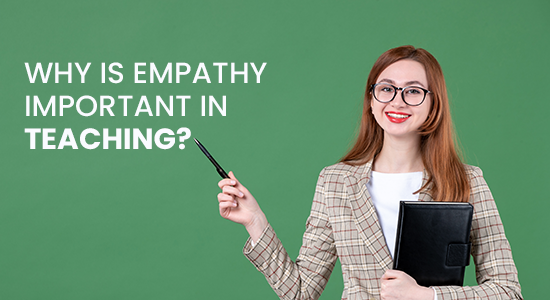Empathy is the ability to understand and share the feelings of another person. It involves putting yourself in someone else's shoes and imagining their feelings. A common theme in empathy involves responding with compassion and understanding.
Here is something to ponder upon. Are we empathetic in our methods of tuition? How can empathy enhance teaching and learning? Are schools today using it as an approach toward wholesome education? Let’s find out what the researchers say at the Education 2.0 Conference!
How Does Empathy Fit In The Education Picture?
In the context of teaching strategy, academic researchers at top-notch education conferences believe that it has manifold benefits. Many such events state that empathy can be a powerful tool for building strong relationships with students when applied to the concept of learning. It can help create a supportive and inclusive classroom environment. Before we dive deeper into expert insights from some of the finest education summits in 2023, let’s understand what empathic learning means and how it pertains to academics.
What Is Empathic Learning?
As the term suggests, Empathic learning refers to applying empathy in imparting education. When teachers empathize with their students, they can better understand their needs, strengths, and challenges. This can help teachers to tailor their instruction to meet the needs of each student, provide meaningful feedback, and create a positive learning experience for all students. Consequently, the learning is enhanced and more effective on the receiver's end.
Does Empathic Learning Have An Impact On Educational Outcome?
Empathy can help teachers to build trust and rapport with their students, which can lead to increased engagement, motivation, and learning outcomes. By showing that they care about their student's well-being and are invested in their success, teachers can create a sense of belonging and community in their classrooms.
Empathy is an important component of effective teaching strategy because it helps teachers to create a supportive and inclusive learning environment, build strong relationships with students, and promote positive learning outcomes in the long run.

Why Is Empathy Important In Teaching?
- Helps build relationships:
When a teacher shows empathy towards their students, it helps to build a positive relationship between them. Students are more likely to trust and respect a teacher who understands and cares about their feelings.
- Enables better communication:
Empathy helps teachers communicate better with their students. When a teacher can understand a student's perspective, they can tailor their communication to be more effective. Mindful words and sensitive sentences are perceived better by students, and it reflects in their performance.
- Promotes a positive learning environment:
Empathy can help to create a positive and inclusive learning environment. Students are more likely to feel valued and supported when a teacher demonstrates empathy toward them. A child might feel left out, bullied or alone, and intimidated by the teacher if they are apathetic and unmindful in their methods.
- Supports student well-being:
Empathy can also support student well-being. When a teacher understands and acknowledges a student's feelings, they can provide appropriate support and resources to help the student cope. This encourages feelings of well-being and satisfaction among students.
- Enhances learning outcomes:
When a teacher is empathetic towards their students, it can enhance learning outcomes. Students are more likely to perform better if they feel understood, safe, and supported by their teacher.
This is the “why” of adopting empathy in learning and teaching. Conversely, education enthusiasts often wonder about the “how” of the equation. Fortunately, there is an educational event in Vegas that can enlighten them.
The panel discussions at the Education 2.0 Conference discuss this topic in detail. In addition to the most recent updates about the world of education, this renowned education summit (especially the upcoming 2023 edition) shares some great tips and tricks to instill empathy in instructional methods. Below are the key points.
Modeling Empathy- A Modern Approach To Empathic Education:
Modelling is a psychological term for showcasing traits in self that one might want to teach others. Teachers can model empathy by corresponding with how to understand and acknowledge students' feelings. When teachers model empathy, it sets an example for students to follow.
Modeling empathy in learning involves demonstrating empathy towards students and creating an environment that fosters empathy and compassion. This involves teachers showing students how to comprehend and recognize the feelings of others and teaching them to respond to others with kindness and understanding.
When teachers model empathy in learning, it can help to create a positive and supportive classroom environment where students feel safe to express themselves, take risks, and collaborate with others.

How Can Teachers Model Empathy In Learning?
Education events in Vegas invite global education experts with experience in empathic teaching. These experts discuss the most debated issues and trends in education today while sharing their perspectives on it. Here are the three key factors that experts believe promote empathic learning:
- Encouraging perspective-taking:
- Teachers can model empathy by encouraging students to take the perspective of others. This involves helping students understand and appreciate different points of view and developing the ability to see things from someone else's perspective.
- Demonstrating kindness:
- Teachers can model empathy by demonstrating kindness and compassion towards others. This can include kindness towards students, colleagues, and broader community members. By watching their teachers be the sweetest version of themselves, students can learn to replicate their kindness.
- Addressing conflicts respectfully:
- When conflicts arise, teachers can model empathy by addressing them respectfully and constructively. This involves listening to all parties, acknowledging each person's perspective, and working towards a solution that benefits everyone.
Teachers can create a classroom environment that fosters empathy, compassion, and understanding by modeling empathy in learning. This can help students develop critical social-emotional skills that will serve them well in and out of the classroom.
Active Listening As A Way To Instill Empathy In Learning:
Teachers can enhance learning outcomes by actively listening to their students. This involves giving their full attention to what the student is saying, clarifying questions, and demonstrating that they are genuinely interested in what the student has to say.
Naturally, this involves acknowledging the emotions of students. When students express their feelings, teachers can recognize and validate them. This helps them understand and manage those emotions positively.
According to some education experts, inclusive language is another way to practice active listening. Some conferences and events suggest that by using inclusive and respectful language for all students, teachers can promote a gender-neutral environment, avoid the scope for stereotypes, and promote mindfulness of cultural differences.
Should Teachers Use Real-life Examples?
Some educationalists believe that it isn't ethical for teachers to use real-life stories to explain concepts as it leads to false image perception. However, researchers at the Education 2.0 Conference shatter this disbelief with valid facts promoting the notion. They believe using real-life examples can help students understand the importance of empathy. Teachers can use stories, case studies, or videos highlighting empathy in action.
Common Practices That Promote Empathy In Students-
- Encouraging perspective-taking:
Teachers can encourage students to take the perspective of others by asking them to consider how others might feel in certain situations. This can help students develop empathy by seeing things from a different point of view.
- Fostering collaboration:
Collaboration can help students develop empathy by working together towards a common goal. Students learn to appreciate and value each other's strengths and contributions when they collaborate.
- Using reflective activities:
Teachers can use reflective activities to help students reflect on their emotions and how they impact others. This can help students develop self-awareness and empathy for others.
- Providing opportunities for service learning:
Service learning can help students develop empathy by engaging in activities that benefit others. This can help students understand the needs of others and develop a sense of responsibility towards their community.
Education conferences and academic events worldwide agree that by incorporating these strategies into their teaching, teachers can help students develop empathy and become more compassionate and understanding.
Do Schools In The USA Employ Empathic Learning?
While many schools in the United States strive to incorporate empathy into their teaching practices, it has yet to be universal across all schools. However, many educational institutions are gradually recognizing its need. Some schools explicitly promote empathic learning through social-emotional learning (SEL) programs or character education. SEL programs teach self-awareness, self-management, social awareness, relationship skills, and responsible decision-making skills, which can help students develop empathy and compassion for others.
Other schools may not have formal programs but may still prioritize empathy in their teaching approach. For example, student-centered teachers are more likely to prioritize empathy as they seek to understand each student's needs and experiences.
There is growing recognition of the importance of empathy in education, and many educators and researchers are advocating for its inclusion in teaching practices. Various academic conferences and events in Vegas discuss the need for all schools to embrace empathic learning as part of their curriculum.
















